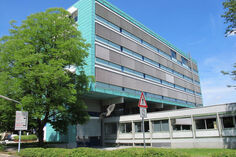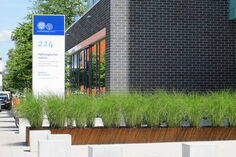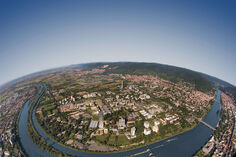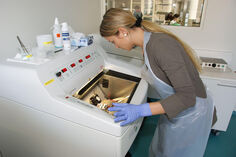ELEKTRONENMIKROSKOPISCHE FORSCHUNG
Elektronenmikroskopische Forschung am Pathologischen Institut dient vorrangig der Aufklärung unbekannter krankheitsrelevanter ultrastruktureller Veränderungen in menschlichen Zellen und Geweben.
Forschungsschwerpunkt von Dr. Ingrid Haußer-Siller ist die Pathogenese seltener Haut- und Bindegewebserkrankungen, insbesondere der Erforschung der Mechanismen der terminalen Differenzierung bzw. Keratinisierung (BMBF-gefördertes „Netzwerk für Ichthyosen und verwandte Keratinisierungsstörungen“ (NIRK)).
Link: NIRK: http://www.netzwerk-ichthyose.de/
Kooperationsanfragen bezüglich Patienten-orientierter Grundlagenforschung an humanem oder Tiermodell-Material werden, soweit möglich, unterstützt. Für technisch und zeitlich aufwändige ultrastrukturelle Forschungsfragestellungen wird auf das Angebot der zuständigen, lokal ansässigen EM-Core Facilities von Universität, bzw. soweit anwendbar DKFZ und EMBL verwiesen.
Link: Elektronenmikroskopie-Core-Facility:
http://emcf.cos.uni-heidelberg.de/EMCF/
Referenzen der letzten 5 Jahre (Excerpt):
2019
Bonafont J, Mencía Á, García M, Torres R, Rodríguez S, Carretero M, Chacón-Solano E, Modamio-Høybjør S, Marinas L, León C, Escamez MJ, Hausser I, Del Río M, Murillas R, Larcher F. Clinically Relevant Correction of Recessive Dystrophic Epidermolysis Bullosa by Dual sgRNA CRISPR/Cas9-Mediated Gene Editing. (2019) Mol Ther. 27:986-998
Fischer-Zirnsak B, Koenig R, Alisch F, Güneş N, Hausser I, Saha N, Beck-Woedl S, Haack TB, Thiel C, Kamrath C, Tüysüz B, Henning S, Mundlos S, Hoffmann K, Horn D, Kornak U. SOPH syndrome in three affected individuals showing similarities with progeroid cutis laxa conditions in early infancy. (2019) J Hum Genet. 64:609-616
Lim PJ, Lindert U, Opitz L, Hausser I, Rohrbach M, Giunta C. Transcriptome Profiling of Primary Skin Fibroblasts Reveal Distinct Molecular Features Between PLOD1- and FKBP14-Kyphoscoliotic Ehlers-Danlos Syndrome. (2019) Genes (Basel). 8;10(7)
2018
Süßmuth K, Gruber R, Rodriguez E, Traupe H, Amler S, Sánchez-Guijo A, Valentin F, Tarinski T, Straub N, Metze D, Schneider SW, Hausser I, Baurecht H, Weidinger S, Oji V. Increased Prevalence of Filaggrin Deficiency in 51 Patients with Recessive X-Linked Ichthyosis Presenting for Dermatological Examination. (2018) J Invest Dermatol;138(3):709-711
Hotz A, Fagerberg C, Vahlquist A, Bygum A, Törmä H, Rauschendorf MA, Zhang H, Heinz L, Bourrat E, Hausser I, Vestergaard V, Dragomir A, Zimmer AD, Fischer J. (2018) Identification of Mutations in SDR9C7 in 6 Families with Autosomal Recessive Congenital Ichthyosis. Br J Dermatol. 178(3):e207-e209
Chmel N, Bornert O, Hausser I, Grüninger G, Borozkin W, Kohlhase J, Nyström A, Has C J Large deletions targeting the triple-helical domain of collagen VII lead to mild acral dominant dystrophic epidermolysis bullosa. (2018) Invest Dermatol 138(4):987-991
Kloss M, Grond-Ginsbach C, Ringleb P, Hausser I, Hacke W, Brandt T. Recurrence of cervical artery dissection: An underestimated risk. (2018) Neurology 90(16):e1372-e1378
Chan WL, Steiner M, Witkos T, Egerer J, Busse B, Mizumoto S, Pestka JM, Zhang H, Hausser I, Khayal LA, Ott CE, Kolanczyk M, Willie B, Schinke T, Paganini C, Rossi A, Sugahara K, Amling M, Knaus P, Chan D, Lowe M, Mundlos S, Kornak U. Impaired proteoglycan glycosylation, elevated TGF-β signaling, and abnormal osteoblast differentiation as the basis for bone fragility in a mouse model for gerodermia osteodysplastica. (2018) PLoS Genet. 2018 14(3):e1007242
Mencía Á, Chamorro C, Bonafont J, Duarte B, Holguin A, Illera N, Llames SG, Escámez MJ, Hausser I, Del Río M, Larcher F, Murillas R. Deletion of a Pathogenic Mutation-Containing Exon of COL7A1 Allows Clonal Gene Editing Correction of RDEB Patient Epidermal Stem Cells. (2018) Mol Ther Nucleic Acids 11:68-78
2017
Van Damme T, Gardeitchik T, Mohamed M, Guerrero-Castillo S, Freisinger P, Guillemyn B, Kariminejad A, Dalloyaux D, van Kraaij S, Lefeber DJ, Syx D, Steyaert W, De Rycke R, Hoischen A, Kamsteeg EJ, Wong SY, van Scherpenzeel M, Jamali P, Brandt U, Nijtmans L, Korenke GC, Chung BH, Mak CC, Hausser I, Kornak U, Fischer-Zirnsak B, Strom TM, Meitinger T, Alanay Y, Utine GE, Leung PK, Ghaderi-Sohi S, Coucke P, Symoens S, De Paepe A, Thiel C, Haack TB, Malfait F, Morava E, Callewaert B, Wevers RA. Mutations in ATP6V1E1 or ATP6V1A Cause Autosomal-Recessive Cutis Laxa. (2017) Am J Hum Genet. 100:216-227
Hausser I. (2017) Classification, diagnosis, and pathogenesis of rare heritable connective tissue disorders: The impact of differential ultrastructural aberrations of dermal connective tissue components. Ultrastruct Pathol. 41:71-72
Hausser I. (2017) Ichthyoses: new insights unravel defects in skin barrier function resulting in diverse clinical and morphological phenotypes. Br J Dermatol. 176:863-864
Worst TS, von Hardenberg J, Gross JC, Erben P, Schnölzer M, Hausser I, Bugert P, Michel MS, Boutros M. (2017) Database-augmented Mass Spectrometry Analysis of Exosomes Identifies Claudin 3 as a Putative Prostate Cancer Biomarker. Mol Cell Proteomics.16:998-1008
Fricke F, Lee J, Michalak M, Warnken U, Hausser I, Suarez-Carmona M, Halama N, Schnölzer M, Kopitz J, Gebert J. (2017) TGFBR2-dependent alterations of exosomal cargo and functions in DNA mismatch repair-deficient HCT116 colorectal cancer cells. Cell Commun Signal. 15:14
Heinz L, Kim GJ, Marrakchi S, Christiansen J, Turki H, Rauschendorf MA, Lathrop M, Hausser I, Zimmer AD, Fischer J (2017) Mutations in SULT2B1 Cause Autosomal-Recessive Congenital Ichthyosis in Humans. Am J Hum Genet. 100:926-939
2016
Kühl T, Mezger M, Hausser I, Guey LT, Handgretinger R, Bruckner-Tuderman L, Nyström A. (2016) Collagen VII Half-Life at the Dermal-Epidermal Junction Zone: Implications for Mechanisms and Therapy of Genodermatoses. J Invest Dermatol. 2016 Jun;136(6):1116-23
Chamorro C, Menacia A, Almarzo D, Duarte B, Büning H, Sallach J, Hausser I, Del Rio M, Larcher F, Murillas R (2016). Gene Editing for the Efficient Correction of a Recurrent COL7A1 Mutation in Recessive Dystrophic Epidermolysis Bullosa Keratinocytes. Mol Ther Nucleic Acids. 5:e307
Has C, Schwieger-Briel A, Schlipf N, Hausser I, Chmel N, Rösler B, Technau K, Jakob T, Zimmer A, Fischer J. (2016) Target-sequence Capture and High Throughput Sequencing Identify a de novo CARD14 Mutation in an Infant with Erythrodermic Pityriasis Rubra Pilaris. Acta Derm Venereol. 96:989-990.
He Y, Maier K, Leppert J, Hausser I, Schwieger-Briel A, Weibel L, Theiler M, Kiritsi D, Busch H, Boerries M, Hannula-Jouppi K, Heikkilä H, Tasanen K, Castiglia D, Zambruno G, Has C. (2016) Monoallelic Mutations in the Translation Initiation Codon of KLHL24 Cause Skin Fragility.Am J Hum Genet. 99:1395-404
2015
Hotz, A, Bourrat E, Hausser I, Haftek M, da Silva MV, Fischer J. (2015) Two novel mutations in the LOR gene in three families with loricrin keratoderma. Br J Dermatol 172:1158-62
Böckler D, Erhart P, Haußer-Siller I, Ellert E, Meredig H, Kovacs B. Klippel-Tréaunay-Weber syndrome associated with abdominal aortic aneurysm in childhood. (2015) J Vasc Surg Cases 1:174-6
Syx D1, Van Damme T, Symoens S, Maiburg MC, van de Laar I, Morton J, Suri M, Del Campo M, Hausser I, Hermanns-Lê T, De Paepe A, Malfait F. (2015) Genetic heterogeneity and clinical variability in musculocontractural Ehlers-Danlos syndrome caused by impaired dermatan sulfate biosynthesis. Hum Mutat. 36:535-47.
Kiritsi D, Valari M, Fortugno P, Hausser I, Lykopoulou L, Zambruno G, Fischer J, Bruckner-Tuderman L, Jakob T, Has C. (2015) Whole-exome sequencing in patients with ichthyosis reveals modifiers associated with increased IgE levels and allergic sensitizations. J Allergy Clin Immunol. 135:280-3.
Valentin F1, Oji V, Hausser I, Liebau E, Tarinski T, Metze D, Breitkreutz D, Traupe H, Jonca N, Terheyden P. (2015) Increased Expression of Caspase-1 and Interleukin-18 in Peeling Skin Disease, and a Novel Mutation of Corneodesmosin Acta Derm Venereol. 95:1019-1021
Lindert U, Weis MA, Rai J, Seeliger F, Hausser I, Leeb T, Eyre D, Rohrbach M, Giunta C. (2015) Molecular Consequences of Defective SERPINH1/HSP47 in the Dachshund Natural Model of Osteogenesis Imperfecta. J Biol Chem. 290:17679-89





